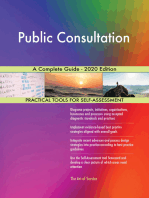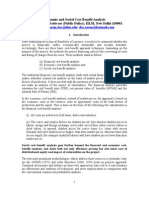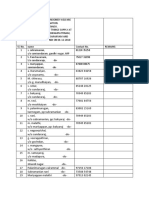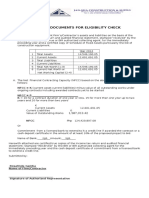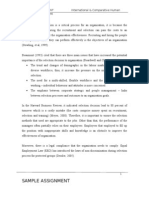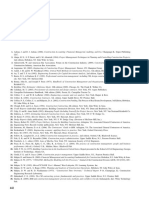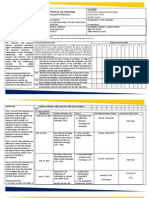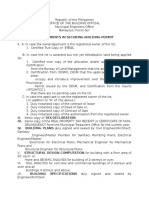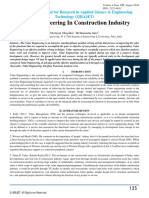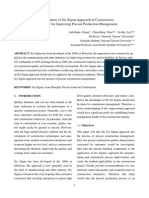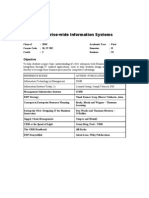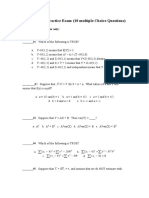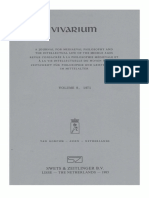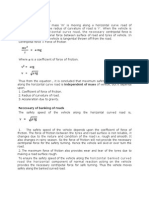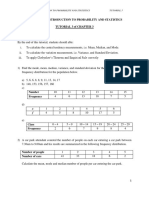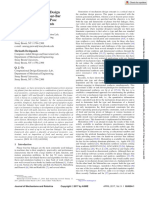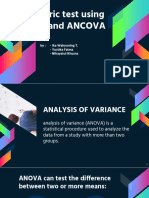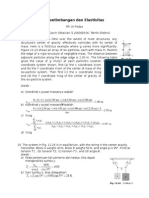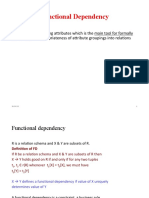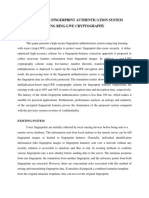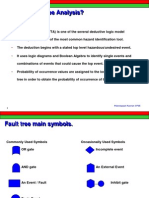Professional Documents
Culture Documents
Vendor Selection Analysis Using Analytical Hierarchy Process (AHP) Method in Engineering, Procurement and Construction (EPC) Business Pt. Rekadaya Elektrika
Copyright
Available Formats
Share this document
Did you find this document useful?
Is this content inappropriate?
Report this DocumentCopyright:
Available Formats
Vendor Selection Analysis Using Analytical Hierarchy Process (AHP) Method in Engineering, Procurement and Construction (EPC) Business Pt. Rekadaya Elektrika
Copyright:
Available Formats
Volume 7, Issue 7, July – 2022 International Journal of Innovative Science and Research Technology
ISSN No:-2456-2165
Vendor Selection Analysis using Analytical Hierarchy
Process (AHP) Method in Engineering, Procurement
and Construction (EPC) Business
Pt. Rekadaya Elektrika
Yonatan Bagus Adi Putra Antonius Setyadi
Master of Management, Lecturer of Postgraduate,
Mercu Buana University Mercu Buana University Jakarta, Indonesia
Abstract:- Vendors have an important role in Supply PT RekadayaElektrikahad the experience in the
Chain Management which will have an impact on Engineering, Procurement and Construction (EPC) in
company performance. One of method that can be used Indonesia, and is a member of the PLN Group. There are 4
in vendor selection is the Analytical Hierarchy Process (four) main business lines run by PT RekadayaElektrika
(AHP) method. This research was conducted at the including; EPC for Power Plant, EPC for Transmission and
company PT Rekadaya Elektrika which is engaged in the Distribution, Trading and Services, and Consulting Services.
national electric power EPC. The sample of this research In running its EPC business, PT RekadayaElektrika cannot
wereall employees in the SCM Unit. The sampling run alone so that PT RekadayaElektrika requires cooperation
technique used in this research is judgment and support from vendors to running thebusiness line. This
sampling.Based on the results from thisresearch, it was is because with the planning and development of a solid
found that the most influential criteria in the selection of strategy from the provider of raw material to the role of
transmission tower material fabrication vendors were logistics, it will produce a qualified product or service. This
the priority I is lead time (0.390), priority II is quality statement is supported by Pujawan and Mahendrawati
(0.246), priority III is price (0.169), priority IV is (2010) Explain the importance of all parties from suppliers,
quantity(0.111) and priority V is service (0.084). From manufacturers, distributors, retailers and customers in
the results of the assessment of alternative priority levels, developing affordable, high quality and fast products.
priority I is Vendor D (0.386), priority II is Vendor E
(0.230), priority III is Vendor C (0.195), priority IV is Currently, many projects have been completed by PT
Vendor B (0.105) and priority V is Vendor A RekadayaElektrika spread throughout Indonesia. After the
(0.066).Based on the results of the analysis Vendor D is project is declared complete, the project team is required to
the vendor that has the highest overall value. make a project close out report. This project close out report
serves to problems and the history of a project that can be
Keywords:- Vendor Selection, Analytical Hierarchy Process used as lessons learned for planning and executing new
(AHP), Supply Chain Management, software expert choice. projects. Problems that arise at PT RekadayaElektrika, based
on project close out report data from previous projects, there
I. INTRODUCTION are problems that arise in the selection of vendors for the
procurement of transmission tower materials. There are 5
Vendors are important in Supply Chain Management (five) Vendors as a sample with various Purchase Order
which will have an impact on company performance. issuance times and fabrication delays. In terms of the length
Therefore, the selection of vendors is an important part in of the Purchase Order issuance process, it occurs due to the
sustaining the running of a project, with a supply of determination of the criteria in the process of determining
materials that are in accordance with demand, delivery the bidder list which changes, so that it requires a fairly long
schedules and affordable costs will result in maximum clarification time. Regarding the delay in fabrication, it is
project profits. So companies need to conduct vendor more indicated by the performance of vendors who are less
assessments carefully and precisely. qualified. So the need for the selection of vendors that fit the
Based on this, management is required to be able to needs of the company.
select vendors carefully and precisely. In selecting vendors, The next process is to determine the analytical tools to
the first step that must be done by the company is to solve the problem. Some of the criteria that influence this
determine the criteria as a reference for the assessment vendor selection decision are qualitative and quantitative.
process. This is in accordance with the opinion of Pujawan Therefore, a method is needed to cover both. The Analytical
and Mahendrawati (2017) who argue that the criteria used in Hierarchy Process (AHP) method can be used to solve
the selection of suppliers are important things that can problems in selecting the vendor (Mubarok, 2017). This
reflect the supply chain strategy and the characteristics of method is used to solve complex problems by building a
the goods to be supplied. hierarchy of criteria, prospects and outcomes, using different
considerations as weights or priorities (Mubarok, 2017).
IJISRT22JUL1376 www.ijisrt.com 965
Volume 7, Issue 7, July – 2022 International Journal of Innovative Science and Research Technology
ISSN No:-2456-2165
II. RESEARCH METHOD
A. Research Design
DELAY OF FABRICATION
TIME FOR PURCHASE ORDER
RELEASE
I I
N N
P PRIMARY DATA SECONDARY DATA P
U U
T T
VENDOR LIST
FORUM GROUP
QUESTIONNAIRE DATA
DISCUSSION
PERFORMANCE VENDOR
ANALYTICAL HYRARCHY PROCESS
(AHP)
P P
R R
O ALTERNATIVE : O
C VENDOR A, VENDOR B, VENDOR C, VENDOR D, C
DAN VENDOR E
E E
S S
S S
CRITERIA :
PRICE, QUALITY, SERVICE, LEAD TIME AND QUANTITY
O O
U U
T IMPLICATIONS TO
T
CONCLUSION SUGGESTION
P MANAGEMENT P
U U
T T
Fig. 1: Research Flowchart
Source: Personal Processed Data, 2022
B. Research Instrument C. Data Processing
Data used in this study include: In this study the method used is the Analytical Hierarchy
Primary data, in the form of questionnaires and the Process (AHP) method. The calculation of the AHP method
results of forum group discussion for employees who can be done using the help of expert choice software. Here
provide an assessment of suppliers. are some steps that must be taken in the selection of
Secondary Data, in the form of data derived from vendors.
historical data or vendor performance records and 1. Develop a hierarchy of problems
vendor lists as well as company tender documents. The hierarchical structure is formed based on the
criteria and subcriteria that will be used in the selection
of the transmission tower material fabrication vendor.
The hierarchical structure in this study can be
described as follows.
IJISRT22JUL1376 www.ijisrt.com 966
Volume 7, Issue 7, July – 2022 International Journal of Innovative Science and Research Technology
ISSN No:-2456-2165
Fig. 2: Research Hierarchy Model
Source: Personal Processed Data, 2022
From the Figure 2.2, it can be seen that level one e. The results in step (d) are then normalized to
is the criteria that will be used including: Price, obtain the eigenvector matrix by averaging the
Quality, Service, Lead Time and Quantity. Level two is number of rows with the criteria used. The
a subcriteria where there are eleven subcriteria used in calculation above shows the eigenvector which is
this study. Next for level three are alternative vendors the priority weight of the criteria used against the
to be selected, including: Vendor A, Vendor B,Vendor goal.
C, Vendor Dand Vendor E. The Formula is :
2. Compile a pairwise comparison matrix that has A.w = λ.w
accommodated the relative influence of each element Description :
on each criterion objective at the level above. w : eigenvector
3. Perform calculations weight or priority on each λ : eigenvalue
criterion variable. The following are the steps in A : square matrix
calculating the weights for each criterion. f. Perform the calculation of the consistency ratio as
a. For each criterion, make of pairwise comparisons follows:
b. Performing the average calculation of the i. Multiply the value of the initial
respondents' assessment results using the comparison matrix by the weight
geometric mean. Averaging these values is ii. Multiply the number of rows by the
mandatory because AHP only knows one answer weight
for the comparison matrix. Mathematically the iii. Calculate max by adding up the product
geometric mean theory can be written with the above divided by n.
followingformula. λmaks=(∑x)/n
1
aij = (Z1, Z2, Z3, … , Zn) ⁄𝑛 iv. Calculating the consistency index can be
Description : measured through CI which is
aij : The average value of pairwise formulated:
comparisons, criteria Ai with Aj for n (λmaks – n)
𝐶𝐼 =
respondents (n – 1)
Z1 : The comparison value between Ai and Aj Description :
for respondent I, with i = 1, 2, 3, .., n CI : consistency index
N : Number of respondents λmaks : maximum eigenvalue
c. The results obtained from pairwise comparisons n : matrix orde
are then displayed in the form of a pairwise v. Calculate the consistency ratio with the
comparison matrix or pairwise comparison following formula:
d. Divide each element in a certain column by the 𝐶𝐼
𝐶𝑅 =
value of the number of that column 𝑅𝐼
IJISRT22JUL1376 www.ijisrt.com 967
Volume 7, Issue 7, July – 2022 International Journal of Innovative Science and Research Technology
ISSN No:-2456-2165
Description :
CR : consistency ratio 5. Calculating of weight or priorityfor each alternative
RI : random index vendor that has been determined with the same
4. Calculating of weight or priority on each subcriteria stages in point 3 above.
that has been determined with the same stages in 6. Determine the vendor to be selected by adding up
point 3 above. Next, determine the global priority the whole of the multiplication of vendor weights
by multiplying the local priority for each subcriteria with subcriteria weights. The overall value of each
against the priority criteria. vendor is what will determine which the best
vendor,it is the vendor with the highest value.
D. Operational Variables
VARIABLES DIMENSIONS INDICATORS
Price feasibility versus quality (P1) Bidding Document
Price
Ability to provide discounted prices (P2) Percentage of Discount
Communication (S1) Response and Feedback
Service Responsiveness to consumer requests (S2) Response and Feedback
Ability to solve problems (S3) Response and Feedback
Ability to provide routine fabrication progress (S4) Progress Report
Production of materials without defects (Q1) Inspection Report
Quality
Material conformity with approved specifications (Q2) Drawing and Spesification
Speed of supply raw material (L1) Material Schedule
Lead Time
Ability to complete fabrication in accordance with the agreement (L2) Contractual Documents
Quantity Conformity with order quantity (J1) Order Quantity / Packing list
Table 1: Table of Operational Variables
Source: Personal Processed Data, 2022
III. RESULTS AND DISCUSSION
A. Priority of Criteria
Fig. 3: Vendor Selection Based on Priority of Criteria
Source: AHP Processing Result, 2022
Selection of the transmission tower material fabrication priority is the price with a weight of 0.169, the fourth
vendor from all the criteria used result is, the first priority priority is the quantity with a weight of 0.111 and the last or
criteria used is lead time with a weight of 0.390, then the fifth priority is the service with a weight of 0.084.
second priority is quality with a weight of 0.246 , the third
IJISRT22JUL1376 www.ijisrt.com 968
Volume 7, Issue 7, July – 2022 International Journal of Innovative Science and Research Technology
ISSN No:-2456-2165
B. Vendor Selection Based on Criteria
Vendor Selection Based on Price Criteria
Fig. 4: Vendor Selection Based on Price Criteria
Source: AHP Processing Result, 2022
In the price criteria, the first priority is Vendor D with of 0.169, the fourth priority is Vendor B with a weight of
a weight of of 0.462, the second priority is Vendor E with a 0.090 and the fifth priority is Vendor A with a weight of
weight of 0.206, the third priority is Vendor C with a weight 0.073.
C. Vendor Selection Based on Service Criteria
Fig. 5: Vendor Selection Based on Service Criteria
Source: AHP Processing Result, 2022
In the service criteria, the first priority is Vendor D weight of 0.192, the fourth priority is Vendor B with a
with a weight of 0.394, the second priority is Vendor E with weight of 0.115 and the fifth priority is Vendor A with a
a weight of 0.247, the third priority is Vendor C with a weight of 0.052.
IJISRT22JUL1376 www.ijisrt.com 969
Volume 7, Issue 7, July – 2022 International Journal of Innovative Science and Research Technology
ISSN No:-2456-2165
D. Vendor Selection Based on Quality Criteria
Fig. 6: Vendor Selection Based on Quality Criteria
Source: AHP Processing Result, 2022
In the quality criteria, the first priority is Vendor D weight of 0.223, the fourth priority is Vendor B with a
with a weight of 0.379, the second priority is Vendor C with weight of 0.106 and the fifth priority is Vendor A with a
a weight of 0.230, the third priority is Vendor E with a weight of 0.063.
E. Vendor Selection Based on Lead Time Criteria
Fig. 7: Vendor Selection Based on Lead Time Criteria
Source: AHP Processing Result, 2022
In the lead time criteria, the first priority is Vendor D weight of 0.211, the fourth priority is Vendor B with a
with a weight of 0.396, the second priority is Vendor C with weight of 0.099 and the fifth priority is Vendor A with a
a weight of 0.235, the third priority is Vendor E with a weight of 0.058.
IJISRT22JUL1376 www.ijisrt.com 970
Volume 7, Issue 7, July – 2022 International Journal of Innovative Science and Research Technology
ISSN No:-2456-2165
F. Selection of Vendors Based on Quantity Criteria
Figure 3.6 Selection of Vendors Based on QuantityCriteria
Source : AHP Processing Result, 2022
In the quantity criteria, the first priority is Vendor E with a weight of 0.314, the second priority is Vendor D with a weight of
0.285, the third priority is Vendor C with a weight of 0.177, the fourth priority is Vendor B with a weight of 0.131, and the fifth
priority is Vendor A with a weight of 0.093.
G. Consistency
Pairwise Comparison CR Description
Betweencriteria 0,03 Consistent
Between price subcriteria 0,00 Consistent
Between servicesubcriteria 0,01 Consistent
Between qualitysubcriteria 0,00 Consistent
Between lead timesubcriteria 0,00 Consistent
Between alternatives to subcriteriaP1 0,02 Consistent
Between alternatives to subcriteriaP2 0,02 Consistent
Between alternatives to subcriteriaS1 0,02 Consistent
Between alternatives to subcriteriaS2 0,02 Consistent
Between alternatives to subcriteriaS3 0,04 Consistent
Between alternatives to subcriteriaS4 0,03 Consistent
Between alternatives to subcriteriaQ1 0,01 Consistent
Between alternatives to subcriteriaQ2 0,02 Consistent
Between alternatives to subcriteriaL1 0,02 Consistent
Between alternatives to subcriteriaL2 0,02 Consistent
Between alternatives to criteria quantity 0,03 Consistent
Table 3.1 Consistency Ratio of Respondents' Assessment
Source : AHP Processing Result, 2022
From Table 3.1 can be seen that there is no CR value that exceeds 0.1 so that all respondents' assessments can be declared
consistent and can be used.
IJISRT22JUL1376 www.ijisrt.com 971
Volume 7, Issue 7, July – 2022 International Journal of Innovative Science and Research Technology
ISSN No:-2456-2165
H. Discussion
Executive Summary AHP Processing
Objectives Selection of the best vendor fabrication tower transmission
Price Subcriteria
1. Ability to provide discounted prices (P2) (0,762)
2. Price feasibility versus quality (P1) (0,238)
ServiceSubcriteria
1. Ability to provide routine fabrication progress (S4)(0,465)
2. Ability to solve problems (S3)(0,275)
3. Communication (S1)(0,161)
Subcriteria
4. Responsiveness to consumer requests (S2)(0,098)
Priority
Quality Subcriteria
1. Material conformity with approved specifications (Q2) (0,751)
2. Production of materials without defects (Q1) (0,249)
Lead Time Subcriteria
1. Ability to complete fabrication in accordance with the agreement (L2) (0,813)
2. Speed of supply raw material (L1) (0,187)
1. Lead Time (0,390)
2. Quality (0,246)
Criteria
3. Price (0,169)
Priority
4. Quantity (0,111)
5. Services (0,084)
1. Vendor D (0,386)
2. Vendor E (0,230)
Alternative
3. Vendor C (0,195)
Priority
4. Vendor B (0,105)
5. Vendor A (0,066)
Table 3.2: Executive Summary AHP Processing
Source: Personal Processed Data, 2022
Based on the results of the AHP processing above, it material on site schedule, thus disrupting field activities. The
can be seen that the most influential criteria in the selection delay of material on site schedule will affect the overall
of transmission tower material fabrication vendors are lead project schedule and the biggest impact is the project cost
time criteria with a weight of 0.390, the next criteria is the (overhead cost) which is still running even though the work
quality criteria on the second priority with a weight of 0.246, on the main material has not yet started. Not to mention if it
the third priorityis the price with a weight of 0.169, the results in a delay in the project completion schedule so that
fourth priority is the quantity with a weight of 0.111 and the PT Rekadaya Elektrika has the potential to get a liquidated
last priority is the service with a weight of 0.084. damages from the owner.
The lead time criteria in this research include 2 (two) Overall result in the selection of transmission material
sub criteria, the speed of supply of raw materials (L1) and fabrication vendors, Vendor D has the first priority with a
the ability to complete the fabrication in accordance with the weight of 0.386, the second priority is occupied by Vendor
agreement (L2). Of the two subcriteria, the subcriteria for E with a weight of 0.230, the third priority is Vendor C with
the ability to complete the fabrication in accordance with the a weight of 0.195, the fourth priority is Vendor B with a
agreement (L2) occupies the first priority with a weight of weight of 0.105 and the last or fifth priority. occupied by
0.813 and the second priority is occupied by the sub criteria Vendor A with a weight of 0.066. Vendor D wins absolutely
for the speed of supply raw materials (L1) with a weight of for the 4 (four) criteria, it is the criteria for price, service,
0.187. quality and lead time. However, for the quantity criteria of
Vendor D is only able to occupy the second priority, where
The most influential of the priority lead time and sub- for the first priority is occupied by Vendor E.
criteria Ability to complete the fabrication in accordance
with the agreement (L2) in the selection of the transmission
tower material fabrication vendor. It can be seen that
PT.RekadayaElektrika prioritizes punctuality in the
fabrication of transmission tower materials. This is not
without reason because the delay in the transmission tower
material fabrication schedule,take effect in a delay the
IJISRT22JUL1376 www.ijisrt.com 972
Volume 7, Issue 7, July – 2022 International Journal of Innovative Science and Research Technology
ISSN No:-2456-2165
IV. CONCLUSION AND RECOMMENDATION International Journal of Innovative Science And
Research Technology.
A. Conclusion
Based on discussion and results of the research, it can be
concluded several things including the following:
The most influential criteria in the selection of the
transmission tower material fabrication vendor is lead
time criteria with a weight of 0.390 as the first priority,
then the second priority is quality with a weight of
0.246, the third priority is price with a weight of 0.169,
the fourth priority is the quantity with a weight of
0.111 and the last or fifth priority is service with a
weight of 0.084.
Based on the criteria and subcriteria used in the
selection of the transmission tower material fabrication
vendor, it can be concluded that Vendor D is the best
vendor in the transmission tower material fabrication
with a weight of 0.386, then for the second priority is
occupied by Vendor E with a weight of 0.230, the third
priority is Vendor C with a weight of 0.195, the fourth
priority is Vendor B with a weight of 0.105 and the last
or fifth priority is occupied by Vendor A with a weight
of 0.066.
B. Recommendation
Based on the results and conclusions of this study, the
authors provide suggestions regarding several things to
the company:
In the bidder list selection process, it is expected that
the bidder list has been filtered on the financial
capabilities of the bidders and weighted the criteria for
determining the bidder list. So it is hoped that the
selection process will produce the best vendor
according to the company's needs.
If at another time there are new criteria that are more in
line with the vendor selection process, it is expected to
be able to re-weight each criteria to be used so that the
results of determining the criteria are not more
subjective.
REFERENCES
[1.] Munthafa, A. E., &Mubarok, H. (2017).
PenerapanMetode Analytical Hierarchy Process
dalamSistemPendukungKeputusanPenentuanMahasisw
aBerprestasi.JurnalSiliwangi, Vol. 3, 192-201.
[2.] Pujawan, I NyomandanMahendrawathi ER.(2010).
Supply Chain Management.Edition 2. Surabaya: Guna
Widya
[3.] Pujawan, I NyomandanMahendrawathi ER.(2017).
Supply Chain Management. Yogyakarta:
Andi.AminWidjaja Tunggal Publisher. 2012. Internal
Auditing, Edition5. Yogyakarta: BPFE
[4.] Achmad H Sutawidjaya, Lenny C Nawangsari. (2019).
OperasiStrategi& Proses Manajemen
:PendekatanPraktisuntukIndustri 4.0. Jakarta:
MitraWacana Media
[5.] AdityaParasian, Antonius Setyadi. (2019). Evaluation
of Supplier Performance using Analytical Hierarchy
Process (AHP) in PT. PelitaAbadiSentosa.
IJISRT22JUL1376 www.ijisrt.com 973
You might also like
- A Vendor Selection in Manufacturing Industry Using AHP and ANNDocument6 pagesA Vendor Selection in Manufacturing Industry Using AHP and ANNthesijNo ratings yet
- A Combined Approach For Supplier Selection: Fuzzy AHP and Fuzzy VIKORDocument8 pagesA Combined Approach For Supplier Selection: Fuzzy AHP and Fuzzy VIKORTI Journals PublishingNo ratings yet
- AHPDocument15 pagesAHPdaimon_pNo ratings yet
- Engineering Economy: Evaluating Projects With The Benefit-Cost Ratio Method - Chapter 10Document36 pagesEngineering Economy: Evaluating Projects With The Benefit-Cost Ratio Method - Chapter 10ismailNo ratings yet
- Chapter 10Document28 pagesChapter 10fahad noumanNo ratings yet
- Enterprise Information System (ICT)Document28 pagesEnterprise Information System (ICT)Etmond PalamaniNo ratings yet
- AHP Balubaid, Rami Alamoudi 2015Document9 pagesAHP Balubaid, Rami Alamoudi 2015ChristinaTriAstutiPauNo ratings yet
- Code of Ethics - ASCEDocument4 pagesCode of Ethics - ASCEGelouDelaCruzMajanNo ratings yet
- Lesson 3 - Planning and Scheduling - Pert-CpmDocument65 pagesLesson 3 - Planning and Scheduling - Pert-CpmChrysler VergaraNo ratings yet
- The Application of Value Engineering On Construction Projects in Lagos State, NigeriaDocument4 pagesThe Application of Value Engineering On Construction Projects in Lagos State, NigeriaInternational Journal of Innovative Science and Research TechnologyNo ratings yet
- Toronto Green Development StandardDocument246 pagesToronto Green Development StandardRay Brooks100% (4)
- Lecture Notes - Value ManagementDocument9 pagesLecture Notes - Value ManagementsympathhiaNo ratings yet
- Reaction Towering InfernoDocument1 pageReaction Towering InfernoshooterNo ratings yet
- 8-Value Engineering (Case Study Example), Monetizing IoT Product-28-02-2023Document66 pages8-Value Engineering (Case Study Example), Monetizing IoT Product-28-02-2023Shubham KodilkarNo ratings yet
- 7 BiddingDocument47 pages7 BiddingShahram Firouzbakht100% (1)
- Building System DesignDocument11 pagesBuilding System DesignAireuxs AdjarainiNo ratings yet
- CCA Mid-Term DetailsDocument5 pagesCCA Mid-Term DetailsRyanCallejaNo ratings yet
- Cost Control and Tracking of A Building by Earned Value MethodDocument8 pagesCost Control and Tracking of A Building by Earned Value MethodAman ThakurNo ratings yet
- Improving Awarness of Green Building Concept in Sri Lanka.Document23 pagesImproving Awarness of Green Building Concept in Sri Lanka.Isurika Ranasinghe100% (1)
- Economic, Social and Environmental Cost Benefit AnalysisDocument5 pagesEconomic, Social and Environmental Cost Benefit AnalysisProfessor Tarun DasNo ratings yet
- Management & Development of Complex Projects LCCDocument38 pagesManagement & Development of Complex Projects LCCasdkjfNo ratings yet
- Lecture 3 - Part 2 - TC70020E - Advanced Construction Procurement and Processes - 2020-21 - w15Document62 pagesLecture 3 - Part 2 - TC70020E - Advanced Construction Procurement and Processes - 2020-21 - w15Jatin ChhabraNo ratings yet
- Benefit/Cost Analysis and Public Sector EconomicsDocument29 pagesBenefit/Cost Analysis and Public Sector EconomicsMahmud RafiNo ratings yet
- Gaja Puyal ListDocument9 pagesGaja Puyal ListVijayssc SivaNo ratings yet
- Engineering Management Modules 1 To 3Document10 pagesEngineering Management Modules 1 To 3abduljabaarNo ratings yet
- ICT Implementation For Materials Management in Construction ProjectsDocument6 pagesICT Implementation For Materials Management in Construction Projectsjohney2No ratings yet
- Underlying Factors of Cost Overruns in Developing Countries: Multivariate Analysis of Jordanian ProjectsDocument17 pagesUnderlying Factors of Cost Overruns in Developing Countries: Multivariate Analysis of Jordanian ProjectsdimlouNo ratings yet
- Lecture 3 - Part 1 TC70020E - Advanced Construction Procurement and Processes - 2020-21 - w15Document48 pagesLecture 3 - Part 1 TC70020E - Advanced Construction Procurement and Processes - 2020-21 - w15Jatin ChhabraNo ratings yet
- Dire Dawa University: Institute of Technology Construction Technology and Management ChairDocument30 pagesDire Dawa University: Institute of Technology Construction Technology and Management ChairSemNo ratings yet
- Financial Documents For Eligibility CheckDocument2 pagesFinancial Documents For Eligibility CheckjjNo ratings yet
- Corruption in The Construction Industry of Nigeria PDFDocument4 pagesCorruption in The Construction Industry of Nigeria PDFGaniNo ratings yet
- Sample Assignment by Ba StudentDocument38 pagesSample Assignment by Ba StudentJuan Pablo OrtizNo ratings yet
- Bibliography - Construction Management (4th Edition)Document3 pagesBibliography - Construction Management (4th Edition)Oliver SenawibowoNo ratings yet
- BS Lab ManualDocument2 pagesBS Lab ManualDharshan KNo ratings yet
- KBrown Course Project Week 1Document3 pagesKBrown Course Project Week 1Kyle BrownNo ratings yet
- Duties and Responsibilities Field EngineersDocument14 pagesDuties and Responsibilities Field EngineersJun Michael0% (1)
- Module 3 Construction Project Procurement and Contract ManagementDocument13 pagesModule 3 Construction Project Procurement and Contract ManagementKej YrastorzaNo ratings yet
- Scheduling Aace International: Schedule DevelopmentDocument1 pageScheduling Aace International: Schedule DevelopmentSucher EolasNo ratings yet
- Comparison of SMM7 With NRM2Document21 pagesComparison of SMM7 With NRM2Mahesh JayawardanaNo ratings yet
- Obe Syllabus HydrologyDocument9 pagesObe Syllabus HydrologyNeil Llacuna PagalaranNo ratings yet
- Design of ConcreteDocument146 pagesDesign of ConcreteMhariecriszReazo100% (1)
- Nicmar Nicmar Institute of Construction Management and Research School of Distance EducationDocument13 pagesNicmar Nicmar Institute of Construction Management and Research School of Distance Educationrahulchauhan7869No ratings yet
- Construction AssignmentF16CE66Document17 pagesConstruction AssignmentF16CE66Azhar Bilawal MemonNo ratings yet
- Requirements Building Permit BanayoyoDocument3 pagesRequirements Building Permit BanayoyoRandolf Dela Cruz TejadaNo ratings yet
- Value Engineering in Construction IndustryDocument4 pagesValue Engineering in Construction Industryz_artist95No ratings yet
- Six Sigma in Precast ProductionDocument11 pagesSix Sigma in Precast Productionravi1625100% (1)
- ALDE - Assignment 1 - DPWH Standard SpecificationsDocument5 pagesALDE - Assignment 1 - DPWH Standard SpecificationsKristia Jolina Buendia Alde100% (1)
- Construction Company Structure Options for New Industrial ParkDocument7 pagesConstruction Company Structure Options for New Industrial ParkkhanNo ratings yet
- Quantity Survey and Cost EstimatesDocument4 pagesQuantity Survey and Cost Estimatesfelix mapilesNo ratings yet
- Construction Project Management 101 (Handouts)Document107 pagesConstruction Project Management 101 (Handouts)Genevieve Gayoso100% (1)
- Pros Cons Handout Delivery SystemsDocument35 pagesPros Cons Handout Delivery SystemsRufus ChengNo ratings yet
- Enterprise-Wide Information SystemsDocument3 pagesEnterprise-Wide Information SystemsjakartiNo ratings yet
- Value Management in Construction ProjectsDocument6 pagesValue Management in Construction ProjectsNurali MamenNo ratings yet
- Project PROCUREMENT ManagementDocument11 pagesProject PROCUREMENT Managementmadry6960% (1)
- Construction Contracts DocuementsDocument48 pagesConstruction Contracts DocuementsChristian AntonioNo ratings yet
- pp1 ReportDocument14 pagespp1 Reportapi-339788639No ratings yet
- An Analysis on Mental Health Issues among IndividualsDocument6 pagesAn Analysis on Mental Health Issues among IndividualsInternational Journal of Innovative Science and Research TechnologyNo ratings yet
- Harnessing Open Innovation for Translating Global Languages into Indian LanuagesDocument7 pagesHarnessing Open Innovation for Translating Global Languages into Indian LanuagesInternational Journal of Innovative Science and Research TechnologyNo ratings yet
- Diabetic Retinopathy Stage Detection Using CNN and Inception V3Document9 pagesDiabetic Retinopathy Stage Detection Using CNN and Inception V3International Journal of Innovative Science and Research TechnologyNo ratings yet
- Investigating Factors Influencing Employee Absenteeism: A Case Study of Secondary Schools in MuscatDocument16 pagesInvestigating Factors Influencing Employee Absenteeism: A Case Study of Secondary Schools in MuscatInternational Journal of Innovative Science and Research TechnologyNo ratings yet
- Exploring the Molecular Docking Interactions between the Polyherbal Formulation Ibadhychooranam and Human Aldose Reductase Enzyme as a Novel Approach for Investigating its Potential Efficacy in Management of CataractDocument7 pagesExploring the Molecular Docking Interactions between the Polyherbal Formulation Ibadhychooranam and Human Aldose Reductase Enzyme as a Novel Approach for Investigating its Potential Efficacy in Management of CataractInternational Journal of Innovative Science and Research TechnologyNo ratings yet
- The Making of Object Recognition Eyeglasses for the Visually Impaired using Image AIDocument6 pagesThe Making of Object Recognition Eyeglasses for the Visually Impaired using Image AIInternational Journal of Innovative Science and Research TechnologyNo ratings yet
- The Relationship between Teacher Reflective Practice and Students Engagement in the Public Elementary SchoolDocument31 pagesThe Relationship between Teacher Reflective Practice and Students Engagement in the Public Elementary SchoolInternational Journal of Innovative Science and Research TechnologyNo ratings yet
- Dense Wavelength Division Multiplexing (DWDM) in IT Networks: A Leap Beyond Synchronous Digital Hierarchy (SDH)Document2 pagesDense Wavelength Division Multiplexing (DWDM) in IT Networks: A Leap Beyond Synchronous Digital Hierarchy (SDH)International Journal of Innovative Science and Research TechnologyNo ratings yet
- Comparatively Design and Analyze Elevated Rectangular Water Reservoir with and without Bracing for Different Stagging HeightDocument4 pagesComparatively Design and Analyze Elevated Rectangular Water Reservoir with and without Bracing for Different Stagging HeightInternational Journal of Innovative Science and Research TechnologyNo ratings yet
- The Impact of Digital Marketing Dimensions on Customer SatisfactionDocument6 pagesThe Impact of Digital Marketing Dimensions on Customer SatisfactionInternational Journal of Innovative Science and Research TechnologyNo ratings yet
- Electro-Optics Properties of Intact Cocoa Beans based on Near Infrared TechnologyDocument7 pagesElectro-Optics Properties of Intact Cocoa Beans based on Near Infrared TechnologyInternational Journal of Innovative Science and Research TechnologyNo ratings yet
- Formulation and Evaluation of Poly Herbal Body ScrubDocument6 pagesFormulation and Evaluation of Poly Herbal Body ScrubInternational Journal of Innovative Science and Research TechnologyNo ratings yet
- Advancing Healthcare Predictions: Harnessing Machine Learning for Accurate Health Index PrognosisDocument8 pagesAdvancing Healthcare Predictions: Harnessing Machine Learning for Accurate Health Index PrognosisInternational Journal of Innovative Science and Research TechnologyNo ratings yet
- The Utilization of Date Palm (Phoenix dactylifera) Leaf Fiber as a Main Component in Making an Improvised Water FilterDocument11 pagesThe Utilization of Date Palm (Phoenix dactylifera) Leaf Fiber as a Main Component in Making an Improvised Water FilterInternational Journal of Innovative Science and Research TechnologyNo ratings yet
- Cyberbullying: Legal and Ethical Implications, Challenges and Opportunities for Policy DevelopmentDocument7 pagesCyberbullying: Legal and Ethical Implications, Challenges and Opportunities for Policy DevelopmentInternational Journal of Innovative Science and Research TechnologyNo ratings yet
- Auto Encoder Driven Hybrid Pipelines for Image Deblurring using NAFNETDocument6 pagesAuto Encoder Driven Hybrid Pipelines for Image Deblurring using NAFNETInternational Journal of Innovative Science and Research TechnologyNo ratings yet
- Terracing as an Old-Style Scheme of Soil Water Preservation in Djingliya-Mandara Mountains- CameroonDocument14 pagesTerracing as an Old-Style Scheme of Soil Water Preservation in Djingliya-Mandara Mountains- CameroonInternational Journal of Innovative Science and Research TechnologyNo ratings yet
- A Survey of the Plastic Waste used in Paving BlocksDocument4 pagesA Survey of the Plastic Waste used in Paving BlocksInternational Journal of Innovative Science and Research TechnologyNo ratings yet
- Hepatic Portovenous Gas in a Young MaleDocument2 pagesHepatic Portovenous Gas in a Young MaleInternational Journal of Innovative Science and Research TechnologyNo ratings yet
- Design, Development and Evaluation of Methi-Shikakai Herbal ShampooDocument8 pagesDesign, Development and Evaluation of Methi-Shikakai Herbal ShampooInternational Journal of Innovative Science and Research Technology100% (3)
- Explorning the Role of Machine Learning in Enhancing Cloud SecurityDocument5 pagesExplorning the Role of Machine Learning in Enhancing Cloud SecurityInternational Journal of Innovative Science and Research TechnologyNo ratings yet
- A Review: Pink Eye Outbreak in IndiaDocument3 pagesA Review: Pink Eye Outbreak in IndiaInternational Journal of Innovative Science and Research TechnologyNo ratings yet
- Automatic Power Factor ControllerDocument4 pagesAutomatic Power Factor ControllerInternational Journal of Innovative Science and Research TechnologyNo ratings yet
- Review of Biomechanics in Footwear Design and Development: An Exploration of Key Concepts and InnovationsDocument5 pagesReview of Biomechanics in Footwear Design and Development: An Exploration of Key Concepts and InnovationsInternational Journal of Innovative Science and Research TechnologyNo ratings yet
- Mobile Distractions among Adolescents: Impact on Learning in the Aftermath of COVID-19 in IndiaDocument2 pagesMobile Distractions among Adolescents: Impact on Learning in the Aftermath of COVID-19 in IndiaInternational Journal of Innovative Science and Research TechnologyNo ratings yet
- Studying the Situation and Proposing Some Basic Solutions to Improve Psychological Harmony Between Managerial Staff and Students of Medical Universities in Hanoi AreaDocument5 pagesStudying the Situation and Proposing Some Basic Solutions to Improve Psychological Harmony Between Managerial Staff and Students of Medical Universities in Hanoi AreaInternational Journal of Innovative Science and Research TechnologyNo ratings yet
- Navigating Digitalization: AHP Insights for SMEs' Strategic TransformationDocument11 pagesNavigating Digitalization: AHP Insights for SMEs' Strategic TransformationInternational Journal of Innovative Science and Research Technology100% (1)
- Drug Dosage Control System Using Reinforcement LearningDocument8 pagesDrug Dosage Control System Using Reinforcement LearningInternational Journal of Innovative Science and Research TechnologyNo ratings yet
- The Effect of Time Variables as Predictors of Senior Secondary School Students' Mathematical Performance Department of Mathematics Education Freetown PolytechnicDocument7 pagesThe Effect of Time Variables as Predictors of Senior Secondary School Students' Mathematical Performance Department of Mathematics Education Freetown PolytechnicInternational Journal of Innovative Science and Research TechnologyNo ratings yet
- Formation of New Technology in Automated Highway System in Peripheral HighwayDocument6 pagesFormation of New Technology in Automated Highway System in Peripheral HighwayInternational Journal of Innovative Science and Research TechnologyNo ratings yet
- As Maths Statistics Unit 2 TestDocument6 pagesAs Maths Statistics Unit 2 TestRamiro A. Guntín RodríguezNo ratings yet
- Bayes Theorem 2Document14 pagesBayes Theorem 2Muhammad YahyaNo ratings yet
- Chapter 5Document37 pagesChapter 5Glydel Ann MercadoNo ratings yet
- What Are Logic Gates With Symbols and Workings?Document6 pagesWhat Are Logic Gates With Symbols and Workings?AakshaNo ratings yet
- UNIT 3 - 4000 Essential English Words 1Document6 pagesUNIT 3 - 4000 Essential English Words 1Virginia AlexeNo ratings yet
- Synonymy: 5 Lexical Semantics: Sense RelationsDocument5 pagesSynonymy: 5 Lexical Semantics: Sense RelationsDjunaidi Komet SharkysNo ratings yet
- Econometrics Practice Exam (10 Multiple Choice Questions) : I. Choose ONE Answer OnlyDocument3 pagesEconometrics Practice Exam (10 Multiple Choice Questions) : I. Choose ONE Answer OnlyTuấn Nguyên NguyễnNo ratings yet
- QB - Offline MCQ Exam - Unit - 2 - IcsDocument5 pagesQB - Offline MCQ Exam - Unit - 2 - IcsNisha MateNo ratings yet
- MonogramDocument2 pagesMonogramLaura Kallao KleckleyNo ratings yet
- Maximizing Returns and Minimizing Risk with Portfolio TheoryDocument47 pagesMaximizing Returns and Minimizing Risk with Portfolio TheoryShubham VarshneyNo ratings yet
- Vivarium - Vol. 9, Nos. 1-2, 1971 PDFDocument163 pagesVivarium - Vol. 9, Nos. 1-2, 1971 PDFL'uomo della RinascitáNo ratings yet
- EGP MergedDocument1,300 pagesEGP MergedKarinaNo ratings yet
- Banking of RoadsDocument4 pagesBanking of RoadsSantSarovarNo ratings yet
- Tutorial 3Document3 pagesTutorial 3Wei WeiNo ratings yet
- MotionGen Interactive Design and EditingDocument10 pagesMotionGen Interactive Design and EditingArif SugihartoNo ratings yet
- Computer Science Worksheet on Ch 8,9,1 and 11Document2 pagesComputer Science Worksheet on Ch 8,9,1 and 11prosenjit basak100% (1)
- 03 PropositionDocument31 pages03 PropositionShakib SalzerNo ratings yet
- 8221 - Tutorial 1 Line IntegralDocument6 pages8221 - Tutorial 1 Line IntegralVictor LoongNo ratings yet
- Anova AncovaDocument10 pagesAnova AncovaYus100% (2)
- PR 10 FisdasDocument3 pagesPR 10 FisdasDavin OktavianNo ratings yet
- 4MB0 01 Que 20160526Document20 pages4MB0 01 Que 20160526abhayNo ratings yet
- Functional Dependency FundamentalsDocument22 pagesFunctional Dependency FundamentalsBharti SharmaNo ratings yet
- Direct Torque Control of Induction MotorDocument19 pagesDirect Torque Control of Induction MotorKumail Hasan NaqviNo ratings yet
- Elitmus Guide - Guide To Solve Cryptic Multiplication QuestionDocument2 pagesElitmus Guide - Guide To Solve Cryptic Multiplication QuestionPraveen Pallav0% (1)
- High SecureDocument6 pagesHigh SecureCrispNo ratings yet
- Smart Algorithms Multimedia ImagingDocument439 pagesSmart Algorithms Multimedia ImagingMukesh PanchalNo ratings yet
- Math exam questions on history of numeration systemsDocument4 pagesMath exam questions on history of numeration systemsTrebor SwissNo ratings yet
- Fta TutorialDocument21 pagesFta Tutorialpj_chaudhary3796No ratings yet
- Business CalculusDocument272 pagesBusiness CalculusMaye Zuñiga Garcia100% (1)
- Math Common CoreDocument10 pagesMath Common CoreLekha TantryNo ratings yet
